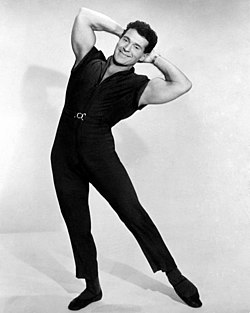Vincent LoBrutto, in his book, TV in the USA, described LaLanne as "one of early television's great pitchmen", saying that he was "full of charisma and vitality and determined to make everyone look and feel better." [3] He engaged viewers in conversation and used items like rubber cords, chairs, and broomsticks when he needed props for exercises. [3] An organ, similar to the ones heard in baseball stadiums, played background music during his exercise routines. [5]
LaLanne often used his white German shepherd dog, Happy, in his program. The dog's tricks attracted children to the program, so that LaLanne could say to the children: "You go get Mother or Daddy, Grandmother, Grandfather, whoever is in the house. You go get them, and you make sure they exercise with me." [6]
This page is based on this
Wikipedia article Text is available under the
CC BY-SA 4.0 license; additional terms may apply.
Images, videos and audio are available under their respective licenses.
